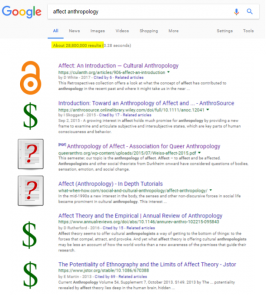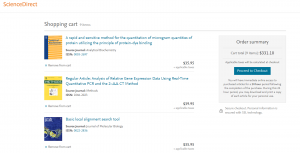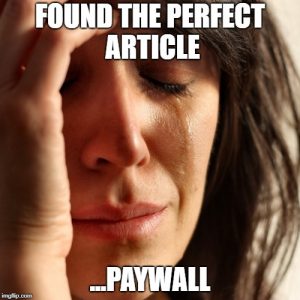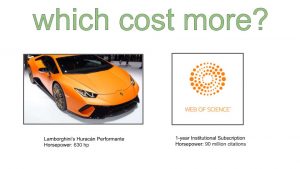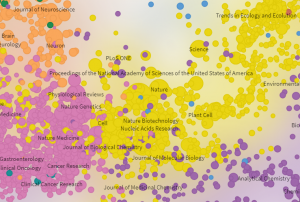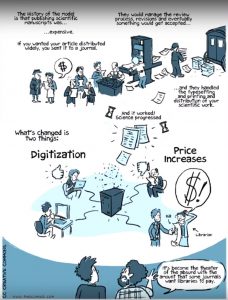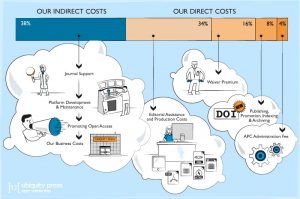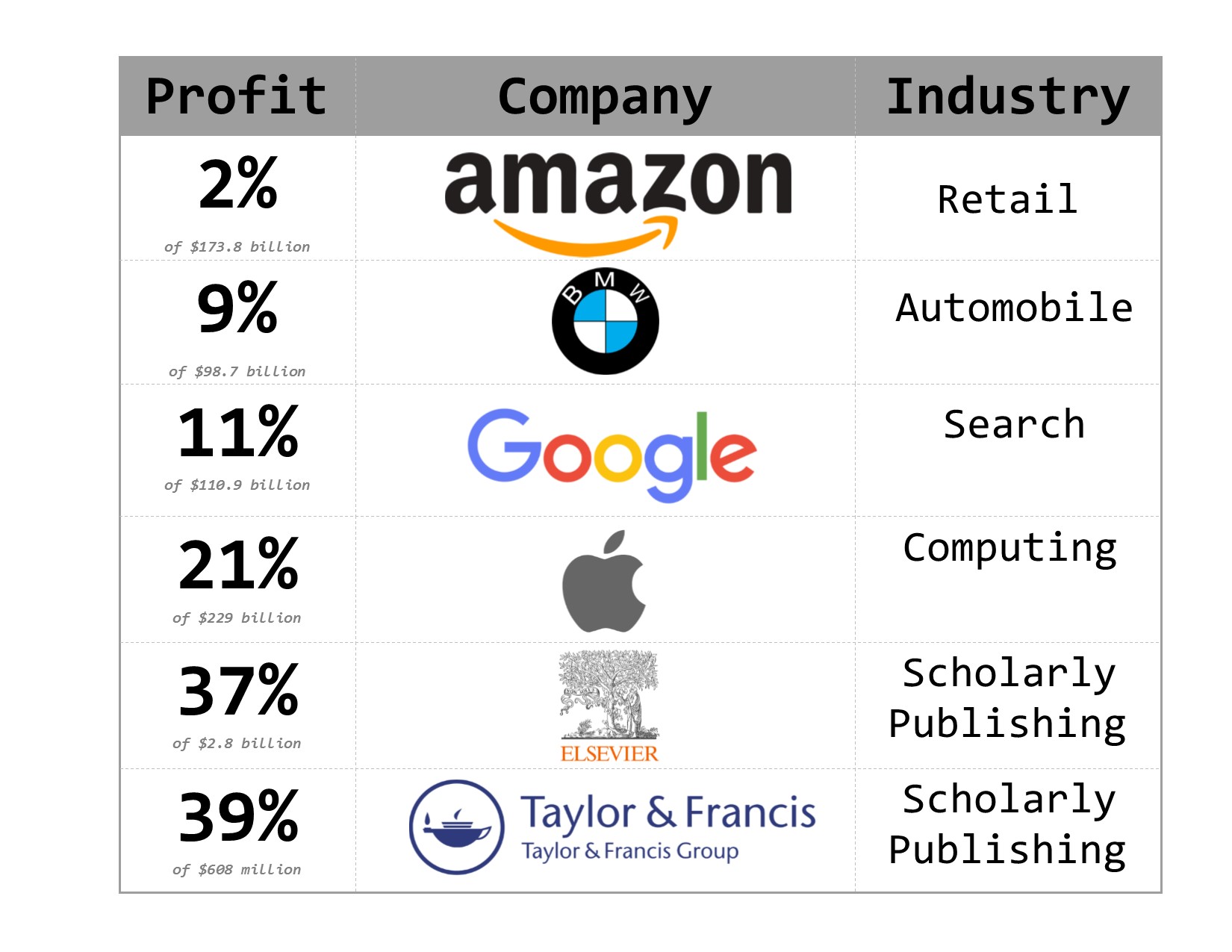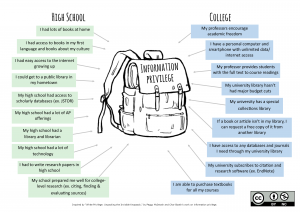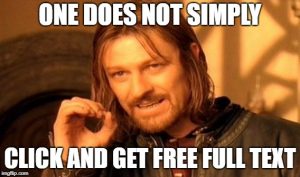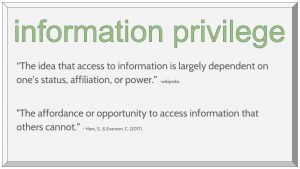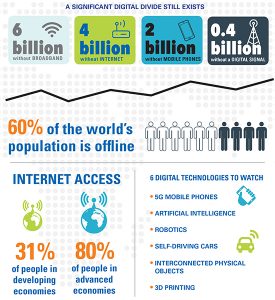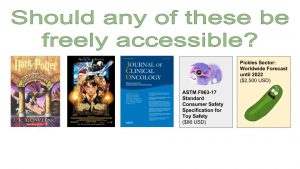Title |
Student-Generated Evaluation Criteria |
|---|---|
| Description | Librarians and instructors can flip an explanation of evaluation criteria by having students in the class generate a list of qualities and characteristics they think are important when selecting sources for their assignments. This will engage students in what they would look for. Librarians and instructors can help facilitate – and add to – the list generated by the students.
Questions (can be adapted):
|
| Steps |
|
| Tags | evaluating-sources; in-class; |
| Time | 10 minutes (during class) |
| Attachments | None. |
Paywalls and Information Costs
Topic |
Paywalls and Information Costs |
|---|---|
| Key Takeaways |
|
|
Notes for the instructor/librarian
|
The topic of paywalls and information costs would be good for any intro-level student to learn about early on. Paywalls are a jarring reminder of the fact that access to scholarly publications is restricted and costs a lot of money. This topic may naturally inspire discussion of “information privilege” and the impact paywalls may have on researchers without institutional access. The issue of piracy (e.g., Sci-hub) might also come up and librarians and instructors should be prepared to discuss the ethics of this. |
| Lesson Content | Below you will find a variety of ways to briefly address this topic. Pick, choose, and adapt as you like. |
| Quick Mentions |
|
| Discussion Questions |
|
| Visuals & Media |
|
| Activities |
|
| Student Readings |
|
Journal Prestige
Topic |
Journal Prestige |
|---|---|
| Key Takeaways |
|
|
Notes for the instructor/librarian
|
This topic could fit well into instruction sessions that include significant treatment of source evaluation, and is one potential approach as you move beyond simple categorization of sources as scholarly/non-scholarly or primary/secondary. It stops short of a critical examination of construction of authority, but could be used to hint at greater subtlety and complexity. This topic has particular relevance for upper level undergraduates engaged in research, who may be starting to think about publication from an author’s perspective. |
| Lesson Content | Below you will find a variety of ways to briefly address this topic. Pick, choose, and adapt as you like. |
| Quick Mentions |
|
| Discussion Questions |
|
| Visuals & Media |
|
| Activities |
|
| Student Readings |
|
Subscriptions and Open Access
Topic |
Subscriptions and Open Access |
|---|---|
| Key Takeaways |
|
|
Notes for the instructor/librarian
|
This topic explores publishing business models, and may only be relevant for instruction sessions where the librarian is able to devote significant time to scholarly communication topics. It could be used as an extension to “sticker shock” topics, or possibly when discussing paywalls or information privilege. It might arise naturally in student discussion of those topics, and so could be useful to have considered in advance. |
| Lesson Content | Below you will find a variety of ways to briefly address this topic. Pick, choose, and adapt as you like. |
| Quick Mentions |
|
| Discussion Questions |
|
| Visuals & Media |
|
| Student Readings |
|
Scale of Scholarly Publishing
Topic |
Scale of Scholarly Publishing |
|---|---|
| Key Takeaways |
|
|
Notes for the instructor/librarian
|
Introducing this topic could be as simple as indicating the impressive number of scholarly articles published each year or size of library collections budgets, or be part of a lengthier lesson on how academic publishing works. It could be included in searching or source evaluation exercises, and may set the stage for understanding the fundamentals of scholarly communication. |
| Lesson Content | Below you will find a variety of ways to briefly address this topic. Pick, choose, and adapt as you like. |
| Quick Mentions |
|
| Discussion Questions |
|
| Visuals & Media |
|
| Student Readings |
|
Information Privilege
Topic |
Information Privilege |
|---|---|
| Key Takeaways |
|
|
Notes for the instructor/librarian
|
This topic could potentially be a touchy subject for students who haven’t thought about these aspects of privilege previously and should be framed carefully. It could be a great fit for an undergraduate course that has any social justice component. Students in these classes might be better primed for talking about disparities/inequalities and could apply that to this concept of information access. However, this discussion can be applicable to any level/discipline. |
| Lesson Content | Below you will find a variety of ways to briefly address this topic. Pick, choose, and adapt as you like. |
| Quick Mentions |
|
| Discussion Questions |
|
| Visuals & Media |
The “invisible knapsack” was introduced by Peggy McIntosh in a 1989 essay she wrote on “white privilege.” The essay describes what privilege (in this case, white privilege) looks like in everyday situations. This image riffs off of this and presents examples of what information privilege might look like. The image could spark a conversation for students about the privileges around info access they have experienced, but had not thought about.
|
| Activities |
|
| Student Readings |
|
Library Icebreaker
Title |
Library Icebreaker |
|---|---|
| Description | Librarians can flip key using-the-library talking points and engage students in discussion with this icebreaker activity. These questions address some of the top/most-frequently-pondered questions that first year students have about using the library.
Questions (can be adapted):
|
| Steps |
|
| Tags | beyond-google; in-class; |
| Time | 10 minutes (during class) |
| Attachments | None. Index cards on Lilly podium, in Music Library, Bostock 023, or make your own! |
Finding a Book
Title |
Finding a Book |
|---|---|
| Description | In post-session feedback, first-year students frequently express anxiety over how to physically navigate the library to find a book on the shelf. This is a simple, pre-session activity to help students try this out before class, so that they can discuss with their librarian any challenges they faced in attempting to complete the task. With the help of the course instructor, students are asked to find a book on their research topic (or course topic) and bring it to class. |
| Steps |
|
| Tags | beyond-google; in-class; pre-assignment |
| Time | 20 minutes (before class); 10 minute discussion |
| Attachments |
Choosing a Topic Flowchart
Title |
Choosing a Topic Flowchart |
|---|---|
| Description | This activity helps students pick or refine a topic that is of personal interest and meets the criteria for their assignment. It is based on the idea that students are more engaged with topics that are of personal interest. It can be used as a standalone worksheet for students to use or can be used as a pre-class activity for them to complete before coming to a library session or other class session. |
| Steps |
|
| Tags | refining-topic; in-class; pre-assignment |
| Time | 10-15 minutes |
| Attachments |
Classifying Sources: the BAAM Method
Title |
Classifying Sources: the BAAM Method |
|---|---|
| Description | This is an activity that uses the framework of BAAM* as a way of helping the students to understand how they would use different kinds of sources in their research papers. BAAM is a way of classifying sources as: Background; Artifact; Argument; Method. The BAAM method is introduced to students before hands-on searching, and then afterwards, as the students begin classifying their results. *Note: We have modified BAAM from Joseph Bizup’s BEAM Method. Substituting Exhibit for Artifact. |
| Steps |
|
| Tags | evaluating-sources; beyond-google; in-class |
| Time | 20-25 minutes total (1o minutes to explain concept; 10-15 minutes to discuss at end of class) |
| Attachments |

